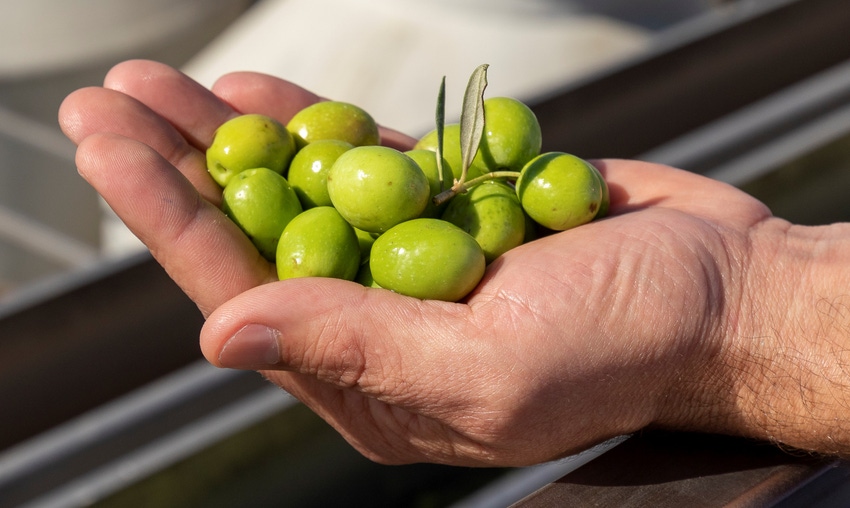
After last year's record fresh olive yields, trees this year produced a much lighter crop much as expected for the alternate-bearing crop. Just how much lighter is a matter of report and conjecture as some put it at 20,000 tons and others say could be closer to 32,000 tons.
The California Olive Committee's projection of 24,000 tons in July became 30,000 tons by the August estimate by the U.S. Department of Agriculture. Dennis Burreson, vice president of field operations and industry affairs for Musco Family Olive. Co. in Tracy, Calif. says total output could be closer to 32,000 tons when factoring unpicked olives.
Bell-Carter Foods, a competing olive processor based in Corning, Calif. was more bearish in a published statement released recently. According to the Bell-Carter statement, the California crop may come in at just over 20,000 tons.
Boom to bust?
California's 2019 olive harvest yielded nearly 90,000 tons of olives. For Burreson, the bigger news of last year's crop wasn't the high overall production, but the yield per acre, which he said was a record for growers. The alternate bearing nature of olives can move per-acre yields from four tons in "off" years to 10 tons in "on" years, Burreson said.
In short, Burreson was not surprised by the latest reports, suggesting that 41 years of experience in the olive industry suggests the trees "were resting following last year's huge yields."
Differing opinions
Bell-Carter said in the prepared statement that California needs six times its current acreage to satisfy domestic demand, which ironically during the COVID-19 pandemic was up while other food sectors saw significant demand reductions due to the closure of restaurants in the United States.
"For the past three decades, the U.S. table olive industry has relied on bulk olives from global sources due to the irrefutable fact that California's table olive supply cannot support U.S. demand," a prepared statement from the company reads. It goes on to point out that table olive acreage continues to decline in California, now down to about 12,000 acres – half of what it was in 2015 and a fraction of what it was just five years earlier.
Musco too saw a similar boost in sales, up over 20 percent for olives as consumers reconnected with the idea of in-home cooking and recipes during the pandemic and the associated shutdown of restaurants.
However, Burreson disagrees strongly with the notion that the U.S. needs six times its current olive acreage to supply domestic demand. Speaking strictly for Musco's abilities and supply as the leading branded olive company in the United States and the world's largest packer and seller of olives, Burreson said California "can definitely meet the demand of U.S. consumers." He went on to say that with a six-fold increase in modern olive acreage, California could supply the world with premium, fresh olives.
Bell-Carter also blames this year's poor crop size on labor availability as much of the California crop must be hand-harvested and crews were not available or in shorter numbers. Poor labor availability led to poor pruning, which netted very little new growth, the company statement continues.
There is some truth to this on both sides. Additionally, the U.S. table olive industry suffered for decades under unfair trade practices that only recently were rectified by the U.S. government. The trade win breathed new life into an industry that saw growers transition to more profitable crops like almonds, walnuts and pistachios.
Competing interests
Early in the 2019 growing season Bell-Carter Foods abruptly cancelled contracts it had with growers, leaving them high and dry with fruit already beginning to set on the trees. Musco stepped in and offered contracts to many of the affected Bell-Carter growers, this as Bell-Carter was apparently repositioning itself in the marketplace.
Musco too was continuing to build its brand of California-grown premium olives sold into retail markets, versus being a supplier of various other qualities of olives sold into the food service industry. This year Musco took in 19,500 tons of olives, according to Burreson. Depending on the figure used for the final crop, this could be as much as 80 percent of the state's fresh olive crop.
Challenges provide opportunity
Not long after Musco offered the grower contracts the company stepped in with its million-tree promise, a move destined to provide free trees to growers willing to participate with Musco's efforts to move the table olive industry to a fully mechanized system. The University of California calls the fresh olive industry "the crop of the future" if it can live up to the goals set forth by those in the industry.
By planting varieties of table olives bred for mechanical harvesting and designed for orchard spacing that allow for 250 trees per acre, versus the 60-80 trees in old-style, hand-picked systems, Burreson believes this and the other efficiencies created by California farmers "will not only produce the highest quality olives in the world but also the most economical olives for U.S. consumers."
About the Author(s)
You May Also Like






